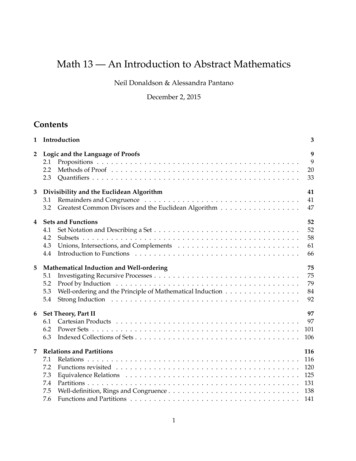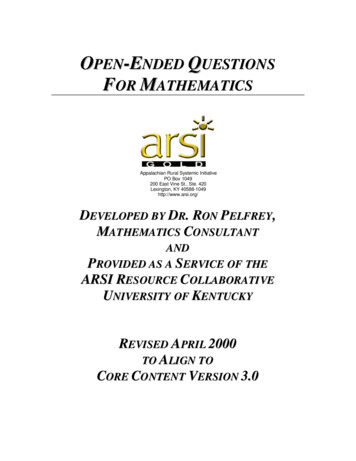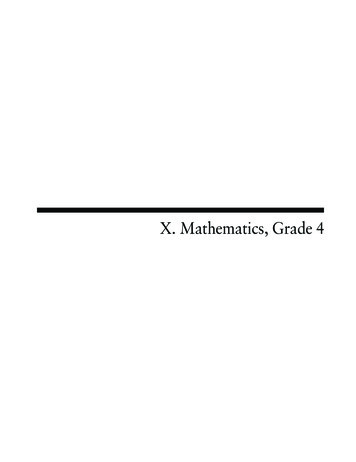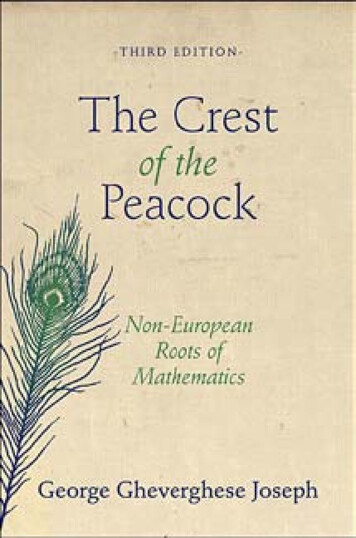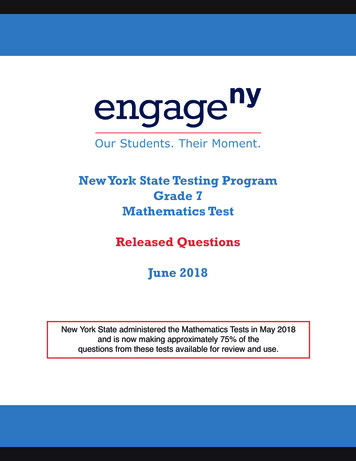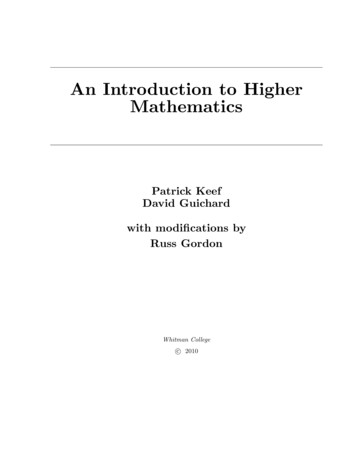
Transcription
An Introduction to HigherMathematicsPatrick KeefDavid Guichardwith modifications byRuss GordonWhitman Collegec 2010
Contents1Logic1.11.21.31.41.51.61.71Logical Operations . . .George Boole . . . .Quantifiers . . . . . . .De Morgan’s Laws . . .Augustus De MorganMixed Quantifiers . . . .Logic and Sets . . . . .René Descartes . . .Families of Sets . . . . .Equivalence Relations . . . . 1. 6. . . 8. . 11. 13. . 15. . 17. 20. . 22. . 242Proofs2.12.22.32.42.52.62.72.829Direct Proofs . . . . . .Divisibility . . . . . . .Existence proofs . . . .Mathematical InductionTwo Important Results .Strong Induction . . . .Well-Ordering Property .Indirect Proof . . . . .Euclid of Alexandria. . . . . . . . . 603235374044495358iii
ivContents3Number Theory3.13.23.33.43.53.63.73.83.9Congruence . . . . . . . . . . . . . . .Carl Friedrich Gauss . . . . . . . .The spaces Zn . . . . . . . . . . . . .The Euclidean Algorithm . . . . . . . .The spaces Un . . . . . . . . . . . . .The GCD and the LCM . . . . . . . .The Fundamental Theorem of ArithmeticWilson’s Theorem and Euler’s Theorem .Leonhard Euler . . . . . . . . . . .Quadratic Residues . . . . . . . . . . .Gotthold Eisenstein . . . . . . . . .Sums of Two Squares . . . . . . . . . .63. . 66. . . . . . . 88. . 97. 4.8Definition and Examples . . . . . . . . . .Induced Set Functions . . . . . . . . . . .Injections and Surjections . . . . . . . . . .More Properties of Injections and SurjectionsPseudo-Inverses . . . . . . . . . . . . . . .Bijections and Inverse Functions . . . . . .Cardinality and Countability . . . . . . . .Uncountability of the Reals . . . . . . . . .Georg Cantor . . . . . . . . . . . . . .103. . . . . . . . 5
1LogicAlthough mathematical ability and opinions about mathematics vary widely, even among educatedpeople, there is certainly widespread agreement that mathematics is logical. Indeed, properlyconceived, this may be one of the most important defining properties of mathematics.Logical thought and logical arguments are not easy to come by (ponder some of the discussionsyou encounter on current topics such as abortion, climate change, evolution, gun control, or samesex marriage to appreciate this statement), nor is it always clear whether a given argument islogical (that is, logically correct). Logic itself deserves study; the right tools and concepts canmake logical arguments easier to discover and to discern. In fact, logic is a major and active areaof mathematics; for our purposes, a brief introduction will give us the means to investigate moretraditional mathematics with confidence.1.1Logical OperationsMathematics typically involves combining true (or hypothetically true) statements in various waysto produce (or prove) new true statements. We begin by clarifying some of these fundamentalideas.By a sentence, we mean a statement that has a definite truth value of either true (T) orfalse (F). For example,“In terms of area, Pennsylvania is larger than Iowa.” (F)“The integer 289 is a perfect square.” (T)Because we insist that our sentences have a truth value, we are not allowing sentences such as“Chocolate ice cream is the best.”“This statement is false.”1
2Chapter 1 Logicsince the first is a matter of opinion and the second leads to a logical dilemma. More generally, bya formula we mean a statement, possibly involving some variables, which is either true or falsewhenever we assign particular values to each of the variables. (Formulas are sometimes referred toas open sentences.) We typically use capital letters such as P , Q, and R to designate formulas.If the truth of a formula P depends on the values of, say, x, y, and z, we use notation like P (x, y, z)to denote the formula.EXAMPLE 1.1 If P (x, y) is “x2 y 12”, then P (2, 8) and P (3, 3) are true, while P (1, 4)and P (0, 6) are false. If Q(x, y, z) is “x y z”, then Q(1, 2, 4) is true and Q(2, 3, 4) is false. IfR(f (x)) is “f (x) is differentiable at 0”, then R(x2 2x) is true and R( x ) is false.Whether a sentence is true or false usually depends on what we are talking about—exactlythe same sentence may be true or false depending on the context. As an example, consider thestatement “the equation x2 1 0 has no solutions.” In the context of the real numbers, thisstatement is true; there is no real number x with the property that x2 1 0. However, if we allowcomplex numbers, then both i and i are solutions to the equation. In this case, the statement“the equation x2 1 0 has no solutions” is false. Examples such as this one emphasize howimportant it is to be perfectly clear about the context in which a statement is made.The universe of discourse for a particular branch of mathematics is a set that contains allof the elements that are of interest for that subject. When we are studying mathematical formulassuch as ‘x divides y’ or ‘f is differentiable at each point’, the variables are assumed to take valuesin whatever universe of discourse is appropriate for the particular subject (the set of integers forthe first example and the set of continuous functions for the second). The universe of discourse isfrequently clear from the discussion, but occasionally we need to identify it explicitly for clarity.For general purposes, the universe of discourse is usually denoted by U .Complicated sentences and formulas are put together from simpler ones using a small numberof logical operations. Just a handful of these operations allow us to represent everything we needto say in mathematics. These operations and their notation are presented below.The denial (or negation) of a formula P is the formula “not P ”, which is written symbolicallyas P . The statement P is false if P is true and vice versa. (This fact follows from the typesof statements we are willing to accept as sentences.) For example, the denial of the false sentence“6 is a prime number” is the true sentence “6 is not a prime number” and the denial of the truesentence “343 is a perfect cube” is the false sentence “343 is not a perfect cube.”The conjunction of the formulas P and Q is the formula “P and Q”, which is written symbolically as P Q. For P Q to be true both P and Q must be true, otherwise it is false. Forexample (the reader can easily identify P and Q),“5 6 and 7 8.” (F)“17 is prime and 324 is a perfect square.” (T)n 1 on 1 k o“ converges to 0 and1 converges to 1.” (F)kkThe disjunction of the formulas P and Q is the formula “P or Q”, which is written symbolicallyas P Q. It is important to note that this is an inclusive or, that is, “either or both”. In other
1.1Logical Operations3words, if P , Q, or both P and Q are true, then so is P Q. The only way P Q can be false is ifboth P and Q are false. For example (once again, the reader can easily identify P and Q),“5 7 or 8 10.” (T)“19 is prime or 4 divides 15.” (T) PPkk 1/2 converges or“2 converges.” (F)k 1k 1Suppose that P and Q are formulas. The sentence “if P , then Q” or “P implies Q” is writtenP Q, using the conditional symbol, . It is not obvious (at least not to most people) underwhat circumstances P Q should be true. In part this is because “if . . . , then . . . ” is used inmore than one way in ordinary English, yet we need to fix a rule that will let us know preciselywhen P Q is true. Certainly, if P is true and Q is false, P cannot imply Q, so P Q is falsein this case. To help us with the other cases, consider the following statement:“If x is less than 2, then x is less than 4.”This statement should be true regardless of the value of x (assuming that the universe of discourseis something familiar, like the integers). If x is 1, it evaluates to T T, if x is 3, it becomesF T, and if x is 5, it becomes F F. So it appears that P Q is true unless P is true and Qis false. This is the rule that we adopt.Finally, the biconditional involving the formulas P and Q is the sentence “P if and only ifQ”, written as P Q. Sometimes the phrase “if and only if ” is abbreviated as “iff ”, but we willnot use this shorthand here. It should be clear that P Q is true when P and Q have the sametruth value, otherwise it is false.EXAMPLE 1.2 Suppose P (x, y) is “x y 2” and Q(x, y) is “xy 1.” Then when x 1 andy 1, the sentences P (x, y), P (x, y) Q(x, y), P (x, y) Q(x, y), P (x, y) Q(x, y), P (x, y) Q(x, y)have truth values F, F, T, F, F, respectively, and when x 2 and y 3, they have truth values T,F, T, T, F, respectively.Using the operations , , , , and , we can construct compound expressions such as(P ( Q)) (( R) (( P ) Q)).As this example illustrates, it is sometimes necessary to include many parentheses to make thegrouping of terms in a formula clear. Just as in algebra, where multiplication takes precedenceover addition, we can eliminate some parentheses by agreeing on a particular order in which logicaloperations are performed. We will apply the operations in this order, from first to last: , , , and . ThusA B C Dis short forA (B (C ( D))).It is generally a good idea to include some extra parentheses to make certain the intended meaningis clear.
4Chapter 1 LogicMuch of the information we have discussed can be summarized in truth tables. For example,the truth table for P is:P PTFFTThis table has two rows because there are only two possibilities for the truth value of P . The otherlogical operations involve two formulas, so they require four rows in their truth tables.PQP QPQP QPQP QPQP ny compound expression has a truth table. If there are n simple (that is, not compound) formulasin the expression, then there will be 2n rows in the table because there are this many different waysto assign T’s and F’s to the n simple formulas in the compound expression. The truth table for(P Q) R isP Q R P Q R (P Q) bserve how the inclusion of intermediate steps makes the table easier to calculate and read.A tautology is a logical expression that always evaluates to T, that is, the last column ofits truth table consists of nothing but T’s. A tautology is sometimes said to be valid. (Although“valid” is used in other contexts as well, this should cause no confusion.) For example, the statement(P Q) P P is a tautology, since its truth table is:PQP Q(P Q) P(P Q) P PTTFFTFTFTFFFTTFFTTTTWe list a few important tautologies in the following theorem, including the names by whichsome of the tautologies are referred to in the literature.
1.1THEOREM 1.3Logical Operations5The following logical statements are tautologies:a) P P (excluded middle)b) P ( P ) (double negation)c) P Q Q Pd) P Q Q Pe) (P Q) R P (Q R)f ) (P Q) R P (Q R)g) P (Q R) (P Q) (P R)h) P (Q R) (P Q) (P R)i) (P Q) ( P Q) (conditional disjunction)j) (P Q) ( Q P ) (contraposition)k) (P (P Q)) Q (modus ponens)l) P (P Q)m) (P Q) Pn) ((P Q) P ) Q (disjunctive syllogism)o) (P Q) ((P Q) (Q P )) (logical biconditional)Proof. The proofs are left as exercises. However, we note in passing that it is not always necessaryto use a truth table to verify a tautology. For example, a proof of (j) can be written as(P Q) ( P Q)by part (i) (Q P )by part (c) ( ( Q) P )by part (b) ( Q P )by part (i)In other words, previous results can sometimes be used to prove other results.In reading through Theorem 1.3, you may have noticed that and satisfy many similarproperties. These are called “dual” notions—for any property of one, there is a nearly identicalproperty that the other satisfies, with the instances of the two operations interchanged. This oftenmeans that when we prove a result involving one notion, we get the corresponding result for itsdual with no additional work.Observe that (c) and (d) are commutative laws, (e) and (f) are associative laws, and (g) and(h) show that and distribute over each other. This suggests that there is a form of algebra forlogical expressions similar to the algebra for numerical expressions. This subject is called BooleanAlgebra and has many uses, particularly in computer science.If two formulas always take on the same truth value no matter what elements from the universeof discourse we substitute for the various variables, then we say they are equivalent. The advantageof equivalent formulas is that they say the same thing but in a different way. For example, algebraicmanipulations such as replacing x2 2x 12 with (x 1)2 13 fit into this category. It is always
6Chapter 1 Logica valid step in a proof to replace some formula by an equivalent one. In addition, many tautologiescontain important ideas for constructing proofs. For example, (o) says that if you wish to showthat P Q, it is possible (and often advisable) to break the proof into two parts, one proving theimplication P Q and the second proving the converse, Q P .Since we just mentioned the term “converse,” this is probably a good place to refresh yourmemory of some familiar terminology. In the conditional sentence P Q, the sentence P is usuallyreferred to as the hypothesis and the sentence Q is called the conclusion. By rearranging and/ornegating P and Q, we can form various other conditionals related to P Q; you may rememberdoing this in a high school geometry class. Beginning with the conditional P Q, the converseis Q P , the contrapositive is Q P , and the inverse is P Q. As an illustration,consider the following important theorem from differential calculus.conditional:If f is differentiable at c, then f is continuous at c.converse:If f is continuous at c, then f is differentiable at c.contrapositive:If f is not continuous at c, then f is not differentiable at c.inverse:If f is not differentiable at c, then f is not continuous at c.As indicated in part (j) of Theorem 1.3, a conditional and its contrapositive always have the sametruth value. It is very important to note that the converse may or may not have the same truthvalue as the given conditional; the previous illustration provides one example where the truth valuesof a statement and its converse are not the same. (Be certain that you can give an example toshow that the converse in this case is false.) It is a common mistake for students to turn theoremsaround without thinking much about it. Be aware of this potential pitfall and think carefully beforedrawing conclusions. The inverse, which is the contrapositive of the converse, is not referred tovery often in mathematics.George Boole. Boole (1815–1864) had only a common school education, though he learnedGreek and Latin on his own. He began his career as an elementary school teacher, but decidedthat he needed to know more about mathematics, so he began studying mathematics, as well asthe languages he needed to read contemporary literature in mathematics. In 1847, he publisheda short book, The Mathematical Analysis of Logic, which may fairly be said to have founded thestudy of mathematical logic. The key contribution of the work was in redefining ‘mathematics’to mean not simply the ‘study of number and magnitude,’ but the study of symbols and theirmanipulation according to certain rules. The importance of this level of abstraction for the futureof mathematics would be difficult to overstate. Probably on the strength of this work, he movedinto a position at Queens College in Cork.In Investigation of the Laws of Thought, published in 1854, Boole established a real formallogic, developing what today is called Boolean Algebra, or sometimes the algebra of sets. Heused the symbols for addition and multiplication as operators, but in a wholly abstract sense.Today these symbols are still sometimes used in Boolean algebra, though the symbols ‘ ’ and ‘ ’,
1.1Logical Operations7and ‘ ’ and ‘ ’, are also used. Boole applied algebraic manipulation to the process of reasoning.Here’s a simple example of the sort of manipulation he did. The equation xy x (which todaymight be written x y x or x y x) means that ‘all things that satisfy x satisfy y,’ or inour terms, x y. If also yz y (that is, y z), then substituting y yz into xy x givesx(yz) x or (xy)z x. Replacing xy by x, we get xz x, or x z. This simple example oflogical reasoning (essentially the transitive property) is used over and over in mathematics.In 1859, Boole wrote Treatise on Differential Equations, in which he introduced the algebraof differential operators. Using D to stand for ‘the derivative of,’ the second order differentialequation ay 00 by 0 cy 0 may be written as aD2 (y) bD(y) cy 0, or in the more compactform (aD2 bD c)y 0. Remarkably, the solutions to aD2 bD c 0, treating D as a number,provide information about the solutions to the differential equation. (If you have taken differentialequations, you should be familiar with this approach to solving linear differential equations.)The information here is taken from A History of Mathematics, by Carl B. Boyer, New York:John Wiley and Sons, 1968. For more information, see Lectures on Ten British Mathematicians,by Alexander Macfarlane, New York: John Wiley & Sons, 1916.Exercises 1.1.1. Determine the truth value of each of the following statements.a) 51 is a prime or 128 is a square.b) 211 is a prime and 441 is a square. k X11c)1 converges to 1 orconverges.k2k 1k 1 XX111and .d) e k!23kk 0e) Xk 11converges ork2f ) The graph of y k 1 Xk 11converges.2k1is concave down on R and1 x2Z 1dx π.1 x2g) If f (x) arctan x, then f 0 (x) 1/(1 x2 ).h) f 00 (x) f (x) if and only if f (x) sin x.2. Construct truth tables for the following logical expressions.a) (P Q) Pb) P (Q P )c) (P Q) (P R)d) P (Q R)3. Verify the tautologies in Theorem 1.3.4. Suppose P (x, y) is the formula “x y 4” and Q(x, y) is the formula “x y”. Find the truth valuesfor the formulasP (x, y) Q(x, y), P (x, y) Q(x, y),P (x, y) Q(x, y),using the values:a) x 1, y 3b) x 1, y 2c) x 3, y 1d) x 2, y 1 (P (x, y) Q(x, y)),
8Chapter 1 Logic5. Write the converse and contrapositive of each of the following conditionals. Use your knowledge ofmathematics to determine if the statements are true or false. (Note that there are three statementsto consider for each part; the original statement and the two new ones derived from it.) For parts (a)and (e), consider different universes and see if the truth values of the statements change.a) If x y, then x3 y 3 .b) If f and g are differentiable on R, then f g is differentiable on R. Pc) Ifan converges, then lim an 0.n 1n d) A convergent sequence is bounded. (Begin by writing this as a conditional involving a variable.)e) If a b, then a2 b2 .1.2QuantifiersRecall that a formula (or open sentence) is a statement whose truth value may depend on thevalues of some variables. For example, the formula “(x 5) (x 3)” is true for x 4 andfalse for x 6. Compare this with the statement “For every x, (x 5) (x 3),” which is falseand the statement “There exists an x such that (x 5) (x 3),” which is true. The phrase“for every x” (sometimes “for all x”) is called a universal quantifier and is denoted by x. Thephrase “there exists an x such that” is called an existential quantifier and is denoted by x. Aformula that contains variables is not simply true or false unless each of the variables is bound bya quantifier. If a variable is not bound, the truth of the formula is contingent on the value assignedto the variable from the universe of discourse.We were careful in Section 1.1 to define the truth values of compound statements precisely. Wedo the same for x P (x) and x P (x), though the intended meanings of these are clear.The Universal QuantifierA sentence x P (x) is true if and only if P (x) is true no matter what value (from the universe ofdiscourse) is substituted for x. To illustrate this notation, let R (the set of all real numbers) be theuniverse of discourse. Then x (x2 0) states that “the square of any real number is nonnegative”; x y (x y y x) represents the commutative law of addition; x y z ((xy)z x(yz)) represents the associative law of multiplication.The “all” form. The universal quantifier is frequently encountered in the form x (P (x) Q(x)),which may be read, “All x satisfying P (x) also satisfy Q(x).” The parentheses are crucial here sobe sure to include them. For example (note how the universe changes in these examples), x (x is differentiable x is continuous) represents “all differentiable functions are continuous”; x (x is a square x is a rectangle) represents “all squares are rectangles”; x (x is a perfect square x is not prime) represents “every perfect square is not a prime.”This construction sometimes is used to express a mathematical sentence of the form “if this,then that,” with an “understood” quantifier. (The last exercise in the previous section illustrateshow quantifiers appear implicitly.)
1.2Quantifiers9EXAMPLE 1.4Let R be the universe of discourse. If we say, “if x is negative, so is its cube,” we usually mean “every negative x has a negativecube.” This should be written symbolically as x ((x 0) (x3 0)). “If two numbers have the same square, then they have the same absolute value” should bewritten as x y ((x2 y 2 ) ( x y )). “If x y, then x z y z” should be written as x y z ((x y) (x z y z)).If S is a set, the sentence “every x in S satisfies P (x)” is written formally as x ((x S) P (x)).(We assume that the reader has some familiarity with sets; a set is a collection of objects and thenotation x S means that the element x belongs to the set S. Sets will be discussed in Section1.5.) For clarity and brevity, this is usually written x S (P (x)) or ( x S)(P (x)) if there is anychance of confusion. To understand and manipulate the formula x S (P (x)) properly, you willsometimes need to “unabbreviate” it, rewriting it as x ((x S) P (x)). With R as the universeof discourse, we use x [0, 1] ( x x) to represent x (x [0, 1] x x); x 0 ( x x) to represent x (x 0 x x).The Existential QuantifierA sentence x P (x) is true if and only if there is at least one value of x (from the universe ofdiscourse) that makes P (x) true. To illustrate this notation, let R be the universe of discourse.Then x (x x2 ) is true since x 0.5 is one of many solutions; x y (x2 y 2 2xy) is true since x y 1 is one of many solutions.For the record, what happens to the truth value for the first of these statements if the universe ofdiscourse is assumed to be the set of positive integers?The “some” form. The existential quantifier is frequently encountered in the following context: x (P (x) Q(x)),which may be read, “Some x satisfying P (x) also satisfies Q(x).” For example (note how theassumed universe changes in these examples), x (x is a perfect square x is a perfect cube, that is, “some perfect squares are perfect cubes”; x (x is a prime number x is even), that is, “some prime number is even”; x (x is bounded x is not integrable), that is, “some bounded function is not integrable”.It may, at first glance, seem that “Some x satisfying P (x) satisfies Q(x)” should be translated as x (P (x) Q(x)),just like the universal quantifier. To see why this does not work, consider the two sentencesP (x) “x is a positive integer” and Q(x) “x is a rational number between 10 and 0.” The
10Chapter 1 Logicsentence “some positive integers are rational numbers between 10 and 0” is certainly false, but x (P (x) Q(x))is true. To see this, suppose x0 7. Then the implication P (x0 ) Q(x0 ) is true (since thehypothesis is false) and the existential quantifier is satisfied.We use abbreviations of the “some” form much like those for the “all” form.EXAMPLE 1.5 Let R be the universe of discourse. x 0 (x2 1) stands for x ((x 0) (x2 1)). x [0, 1] (2x2 x 1) stands for x ((x [0, 1]) (2x2 x 1)).If corresponds to “all” and corresponds to “some”, do we need a third quantifier to correspond to “none”? As the following examples show, this is not necessary: “No perfect squares are prime,” can be written x (x is a perfect square x is not prime); “No triangles are rectangles,” can be written x (x is a triangle x is not a rectangle); “No unbounded sequences are convergent,” can be written x (x is an unbounded sequence x is not convergent).In general, the statement “no x satisfying P (x) satisfies Q(x)” can be written as x (P (x) Q(x))or, equivalently, as x (Q(x) P (x)).(You may wonder why we do not use x (P (x) Q(x)). In fact, we could—it is equivalent to x (P (x) Q(x)); such statements will be considered in the next section.)Exercises 1.2.Except for problems 2 and 3, assume that the universe of discourse is the set of real numbers.1. Express the following as formulas involving quantifiers.a) Any number raised to the fourth power is nonnegative.b) Some number raised to the third power is negative.c) The sine of a number is always between 1 and 1, inclusive.d) 10 raised to any negative power is strictly between 0 and 1.2. Let U represent the set of all living people, let T (x) be the statement “x is tall”, and let B(x) be thestatement “x plays basketball”. Express the following as formulas involving quantifiers.a) All basketball players are tall.b) Some tall people play basketball.c) Not all basketball players are tall.d) No tall person plays basketball.3. Suppose X and Y are sets. Express the following as formulas involving quantifiers.a) Every element of X is an element of Y .b) Some element of X is an element of Y .c) Some element of X is not an element of Y .d) No element of X is an element of Y .4. Recall (from calculus) that a function f is increasing on R if a b (a b f (a) f (b))Express the following related definitions as formulas involving quantifiers.a) f is decreasing on Rb) f is constant on Rc) f has a zero (f (x) 0 has a solution)
1.3De Morgan’s Laws115. Express the following algebraic laws symbolically:a) the commutative law of multiplicationb) the associative law of additionc) the distributive law6. Are the following sentences true or false? Explain your answers.a) x y (x y x2 y 2 )b) x y z 6 0 (xz yz x y)c) x 0 y 0 (x2 xy y 2 3)d) x y z (x2 y 2 z 2 2xy 2 2z)1.3De Morgan's LawsIf P is some sentence or formula, then (as we have seen) P is called the denial or negationof P . The ability to manipulate the denial of a formula accurately is critical to understandingmathematical arguments. The following tautologies are referred to as De Morgan’s Laws: (P Q) ( P Q)and (P Q) ( P Q).These are easy to verify using truth tables, but with a little thought, they are not hard to understanddirectly. The first says that the only way that P Q can fail to be true is if both P and Q fail tobe true. For example, the statements “x is neither positive nor negative” and “x is not positiveand x is not negative” clearly express the same thought. For an example of the second tautology,consider “x is not between 2 and 3.” This can be written symbolically as ((2 x) (x 3)), andclearly is equivalent to (2 x) (x 3), that is, (x 2) (x 3).We can also use De Morgan’s Laws to simplify the denial of P Q: (P Q) ( P Q) ( P ) ( Q) P Qso the denial of P Q is P Q. (What is the justification for the first step?) In other words, itis not the case that P implies Q if and only if P is true and Q is false. Of course, this agrees withthe truth table for P Q that we have already seen.There are versions of De Morgan’s Laws for quantifiers: x P (x) x P (x); x P (x) x P (x).You may be able to see that these are true immediately. If not, here is an explanation for thestatement x P (x) x P (x) that should be convincing. If x P (x) is true, then P (x) is nottrue for every value of x, which is to say that for some value a, P (a) is not true. This means that P (a) is true. Since P (a) is true, it is certainly the case that there is some value of x that makes P (x) true and hence x P (x) is true. The other three implications may be explained similarly.
12Chapter 1 LogicHere is another way to think of the quantifier versions of De Morgan’s Laws. The statement x P (x) is very much like a conjunction of many statements. If the universe of discourse is the setof positive integers, for example, then x P (x) P (1) P (2) P (3) · · ·and its negation would be x P (x) P (1) P (2) P (3) · · · P (1) P (2) P (3) · · · x P (x).Similar reasoning shows that the second quantifier law can also be interpreted this way.Finally, general understanding is usually aided by specific examples. Suppose the universe isthe set of cars. If P (x) is “x has four wheel drive,” then the denial of “every car has four wheeldrive” is “there exists a car which
1.1 Logical Operations 3 words, if P, Q, or both P and Q are true, then so is P _Q.The only way P _Q can be false is if both P and Q are false. For example (once again, the reader can easily identify P and Q), \5 7






